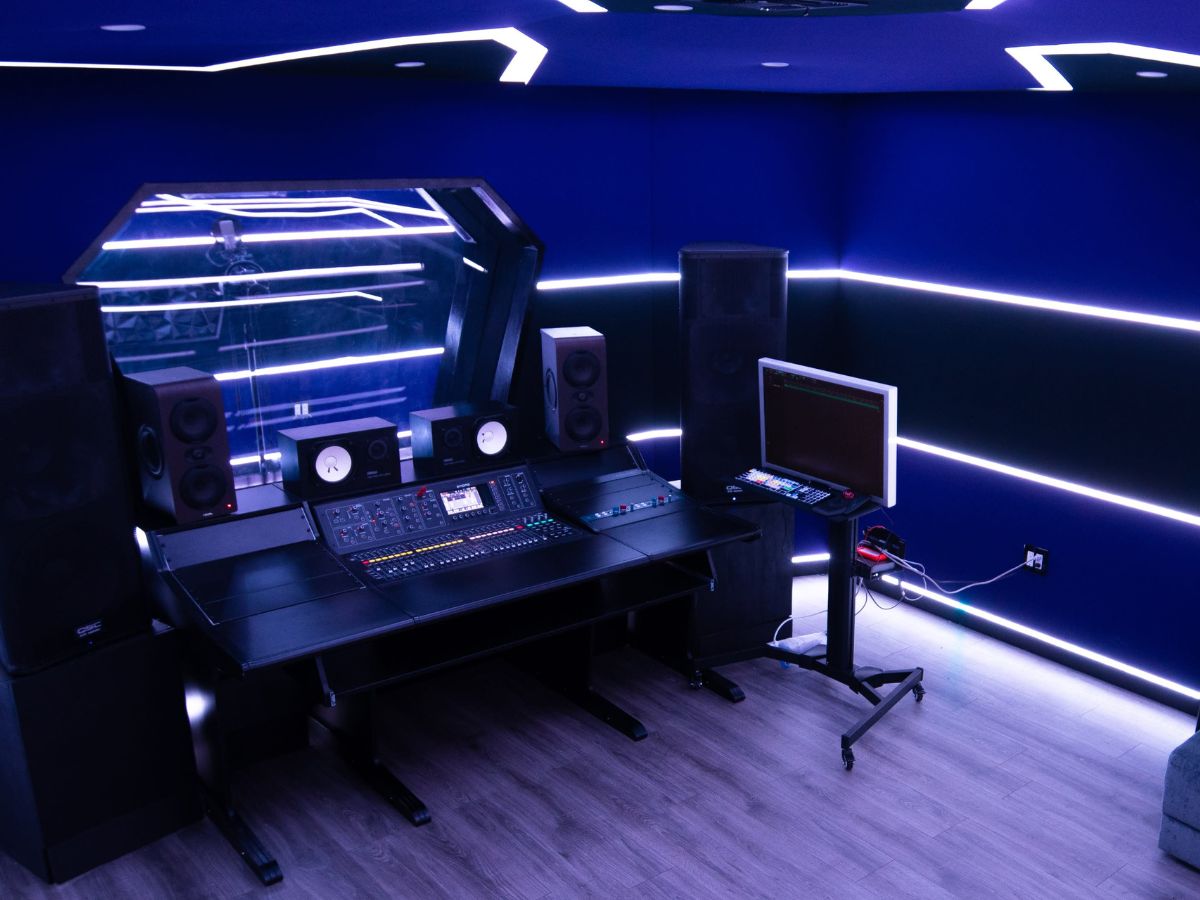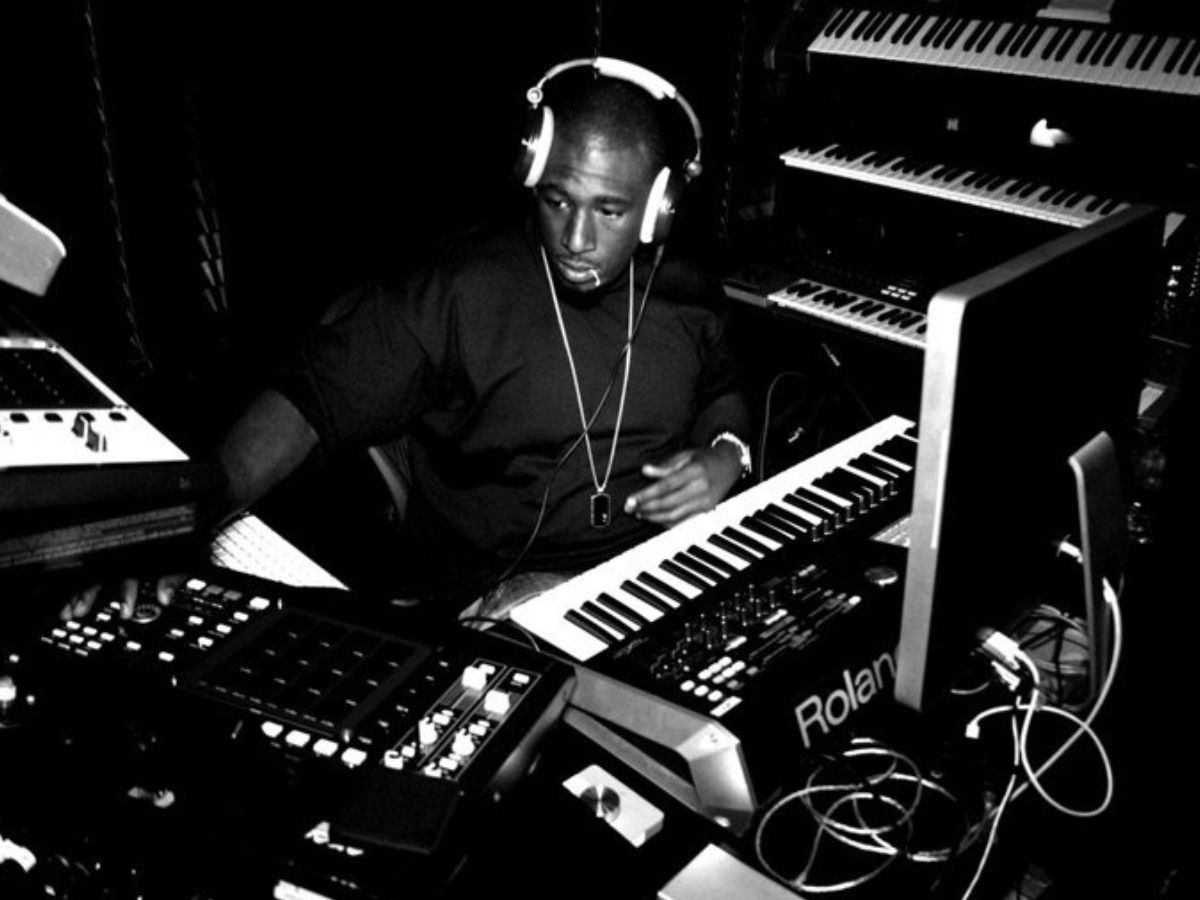

Hip Hop
How To Get Low Hip Hop Bass
Modified: February 18, 2024
Learn the secrets to achieving powerful and low-hitting hip hop bass in your tracks with this comprehensive guide. Enhance your beats with expert techniques and elevate your hip hop production skills.
(Many of the links in this article redirect to a specific reviewed product. Your purchase of these products through affiliate links helps to generate commission for AudioLover.com, at no extra cost. Learn more)
Table of Contents
Introduction
Welcome to the world of hip hop bass! When it comes to the genre of hip hop, a thumping and powerful bass is a crucial element that keeps the beats bumping and the crowd moving. Whether you’re a producer, DJ, or just a casual listener, understanding how to get that low hip hop bass can take your music to the next level.
Hip hop music is known for its heavy emphasis on bass, which provides the foundation for the entire track. From the booming 808 kicks to the deep basslines, the low end is what gives hip hop its signature sound. It’s what makes your car speakers rattle and the dance floor shake.
In this article, we’ll explore the key techniques and equipment needed to achieve that low hip hop bass you’ve been craving. We’ll dive into everything from choosing the right equipment to setting up your gear properly. We’ll also discuss different methods of creating a solid foundation for your bass and ensuring that it sits well in the mix.
But why is hip hop bass so important? Well, the bass serves multiple functions in hip hop music. It not only anchors the rhythm and groove but also adds a sense of depth and power to the overall sound. A well-crafted bassline can make or break a hip hop track, instantly grabbing the listener’s attention and setting the mood for the rest of the song.
Whether you’re aiming for that booming, chest-rattling low end or a more intricate and melodic bassline, this article will guide you through the necessary steps to achieve your desired sound. So, let’s dive in and unlock the secrets of low hip hop bass!
Understanding Hip Hop Bass
Before delving into the technicalities of producing low hip hop bass, it is essential to have a solid understanding of the role and characteristics of bass in hip hop music. The bass serves as the anchor of the track, providing a foundation for the rhythmic elements and creating a sense of groove and impact.
In hip hop, the bass is typically characterized by its low frequency range, often utilizing deep sub-bass tones and powerful low-end kicks. This heavy emphasis on the lower frequencies gives hip hop its signature thumping and resonating sound.
One of the key components of hip hop bass is the iconic 808 kick drum. Originating from the Roland TR-808 drum machine, the 808 kick has become synonymous with hip hop production. It produces a deep and booming bass sound that has been widely used in various subgenres of hip hop.
In addition to the 808 kick, hip hop basslines can also incorporate melodic elements. This can be achieved through the use of instruments such as bass guitars, synths, or sampled basslines from classic funk and soul records. These melodic basslines add a unique flavor to the overall sound and can create a catchy and memorable hook.
It’s important to remember that while the bass is a prominent element in hip hop, it shouldn’t overpower the other instruments or vocals in the mix. Achieving a balanced and well-defined bass sound requires careful attention to mixing techniques, proper EQing, and effective use of compression.
Now that you have a basic understanding of the role and characteristics of hip hop bass, it’s time to explore the equipment and techniques needed to achieve that low and powerful bass sound. So, let’s move on to the next section and uncover the secrets of choosing the right equipment for your hip hop production needs.
Choosing the Right Equipment
When it comes to getting that low hip hop bass, having the right equipment is crucial. The right gear can make a significant difference in the quality and impact of your bass sound. Here are some key factors to consider when selecting equipment for your hip hop production:
- Studio Monitors or Headphones: A reliable pair of studio monitors or headphones is essential for accurately hearing and mixing the low frequencies of your bass. Look for models that have a flat frequency response and can reproduce low-end frequencies accurately.
- Bass Synthesizers or Samplers: If you’re creating basslines from scratch, consider investing in a bass synthesizer or sampler. These instruments allow you to shape and design your bass sounds to achieve the desired depth and character. Look for synths or samplers that offer a wide range of low-frequency options and customization capabilities.
- Audio Interface: An audio interface is necessary for connecting your studio monitors or headphones to your computer. Choose an interface with high-quality digital-to-analog converters (DACs) to ensure accurate and detailed bass reproduction.
- MIDI Controllers: MIDI controllers allow you to play and control virtual instruments or software synthesizers. Look for controllers with responsive and velocity-sensitive keys to accurately translate your bassline ideas into playable melodies or riffs.
- Sampling and Drum Machines: If you’re using sampled basslines or working with drum machines, consider investing in equipment specifically designed for sampling and drum sequencing. These tools can provide a wide range of sounds and effects tailored for hip hop production.
- Equalizer (EQ): An EQ is an indispensable tool for shaping the tonal balance of your bass. Look for EQ plugins or hardware units that allow precise control over the low frequencies, enabling you to boost or cut specific bass frequencies to achieve clarity and impact.
Remember, the quality of your equipment directly influences the quality of your bass sound. While it’s important to invest in reliable and professional gear, it’s also crucial to make the most of what you have. Even with modest equipment, you can still achieve incredible results with proper technique and creativity.
Now that you’ve got your equipment sorted, let’s move on to the next section where we’ll discuss how to set up your gear for optimal bass production.
Setting up Your Equipment
Once you have chosen the right equipment for your hip hop production, it’s time to set everything up for optimal bass production. Proper equipment setup ensures that you can accurately monitor and control the low frequencies, resulting in a clean and impactful bass sound. Here are some steps to consider when setting up your gear:
- Room Acoustics: Pay attention to the acoustics of your recording or mixing space. Consider treating your room with acoustic panels or bass traps to reduce unwanted reflections and bass buildup. This will create a more accurate listening environment for bass monitoring.
- Speaker Placement: Position your studio monitors or speakers correctly for optimal bass response. Avoid placing them too close to walls or corners, as this can cause bass resonance and muddiness. Experiment with speaker placement to find the best balance between low-end accuracy and overall sound imaging.
- Subwoofer Integration: If you have a dedicated subwoofer, ensure it is properly integrated with your studio monitors or speakers. Set the crossover frequency and volume levels of the subwoofer to blend seamlessly with your main speakers, enhancing the low-end extension and impact of your bass.
- Audio Interface Configuration: Connect your audio interface to your computer and configure it properly. Set the sample rate and buffer size according to your project’s requirements. Ensure that you have low-latency settings for real-time monitoring and precise bass performance.
- Calibration and Reference Tracks: Use calibration tools and reference tracks to ensure accurate monitoring of the low frequencies. Additionally, select reference tracks that feature well-mixed and impactful bass elements to compare and evaluate your own bass sound during the mixing process.
- Routing and Cable Management: Organize your audio cables and routing in a neat and organized manner. Proper cable management minimizes the chance of interference and ensures a clean signal flow between your equipment, reducing noise and maintaining signal integrity.
Remember to take your time when setting up your equipment and pay attention to the details. Small adjustments in positioning, speaker placement, and audio interface settings can have a significant impact on how you perceive and control the low frequencies in your mix.
Now that your equipment is set up, it’s time to dive into the techniques and methods for creating a solid foundation for your low hip hop bass. In the next section, we’ll explore different approaches to laying down the groundwork for your basslines. Let’s continue the journey!
Creating Foundation for Low Bass
When it comes to crafting a powerful and impactful low hip hop bass, creating a solid foundation is essential. The foundation sets the stage for all the other elements of your track, ensuring that the bass sits well in the mix and drives the energy of the song. Here are some techniques to help you establish a strong foundation for your low bass:
- Start with a Strong Kick Drum: The kick drum forms the backbone of your bass foundation. Choose a kick sample that has a deep and punchy character, with a strong low-end presence. Layer multiple kick samples to add richness and enhance the impact of the kick in the mix.
- Create a Catchy Bassline: Craft a bassline that complements the rhythm and groove of your track. Experiment with different notes, rhythms, and patterns to find a bassline that grabs the listener’s attention and adds depth to the overall sound. Consider incorporating slides, glides, or other legato techniques to create a smooth and fluid bass movement.
- Use Layering Techniques: Layering your bass sounds can add richness and complexity to the foundation. Blend multiple bass sounds, such as a punchy 808 kick, a deep sub-bass, and a melodic bass instrument, to create a unique and full-bodied foundation. Use EQ and volume adjustments to ensure each layer sits well in the mix and contributes to the overall impact.
- Consider Mono Compatibility: Check the mono compatibility of your bass foundation to ensure that it translates well on different playback systems. Low frequencies, especially sub-bass tones, can become less defined in mono. Use techniques like phase cancellation testing or stereo imaging plugins to check for phase issues that can affect the bass foundation when collapsed to mono.
- Pay Attention to Timing and Groove: Tight timing and groove are essential for a solid bass foundation. Ensure that the kick drum and bassline are synchronized and lock in with the rhythm of the track. Experiment with swing or shuffle settings to add groove and make your bassline feel more natural and lively.
- Assess and Refine the Balance: Continuously assess the balance between the kick drum and bassline. Adjust the volume and EQ of each element to achieve a balanced and powerful low-end. Use sidechain compression to create space for the kick by ducking the bassline whenever the kick hits, ensuring that both elements coexist harmoniously.
Remember, creating a foundation for your low bass takes time and experimentation. Trust your ears and make adjustments based on what sounds best for your particular track. Manipulating the kick drum, crafting a catchy bassline, utilizing layering techniques, and maintaining a strong sense of timing and groove will help you lay down a solid foundation for your low hip hop bass.
Now that we have established the foundation, it’s time to delve into the art of EQ and explore techniques to enhance the clarity and impact of your low bass. In the next section, we’ll uncover how to utilize EQ effectively in shaping your bass sound. Let’s keep the groove going!
Utilizing EQ Techniques
EQ (Equalization) is a powerful tool that plays a crucial role in shaping the tonal balance and clarity of your low hip hop bass. By utilizing EQ techniques effectively, you can enhance the presence and impact of your bass while ensuring it sits well in the mix. Here are some EQ techniques to consider:
- High-pass Filtering: Start by applying a high-pass filter to remove unnecessary low frequencies from elements that don’t contribute to the bass foundation, such as vocals or non-essential instruments. This helps create more space for the low-end elements to breathe, reducing muddiness and improving overall clarity.
- Boosting Sub-bass Frequencies: Identify the sub-bass frequencies (around 20-60Hz) that give your bass its deep and powerful character. Use a narrow bandwidth or parametric EQ to boost these frequencies and add weight to your bassline. Be cautious not to overdo it, as excessive boosting can lead to distortion or an unbalanced mix.
- Controlling Muddiness: Be mindful of the lower midrange frequencies (around 200-500Hz) that can contribute to a muddy or boomy sound. Use a narrow Q factor to cut or reduce problematic frequencies in this range, particularly if they clash with other elements in the mix. This helps maintain clarity and separation between instruments.
- Sculpting the Presence: Add brightness and presence to your bassline by selectively boosting higher frequencies (around 1kHz to 5kHz). This can help your bass cut through the mix and be more audible on smaller playback systems or devices with limited low-frequency response.
- Using Mid-Side Processing: Utilize mid-side EQ processing to sculpt the stereo image of your bass. Boosting the side channels’ higher frequencies can widen the perception of your bass, while making adjustments to the mid channel can ensure a solid and centered foundation.
- Dynamic EQ for Control: Consider using dynamic EQ to tame any frequency peaks or resonances that occur during particular sections of your bassline. Dynamic EQ allows you to apply EQ adjustments only when certain frequencies cross a specified threshold, helping to maintain a balanced and controlled bass sound.
- Compare and A/B Test: Regularly compare your bass EQ settings with reference tracks to ensure you’re achieving a balanced and professional sound. Use A/B testing to compare the EQ adjustments you’ve made and evaluate if they improve the impact and clarity of your bass.
Remember, every track is different, and there is no one-size-fits-all approach to EQ. Trust your ears and make adjustments based on the specific needs of your bassline and the overall mix. Experimentation, practice, and a keen ear for detail will help you achieve a well-defined and impactful low hip hop bass.
Now that we’ve explored EQ techniques, let’s move on to the next section, where we’ll delve into the use of subwoofers to further enhance the low-end presence of your bass. Let’s dive in!
Incorporating Subwoofers
Subwoofers are a valuable tool when it comes to enhancing the low-end presence and impact of your low hip hop bass. These dedicated speakers are designed to reproduce ultra-low frequencies, providing a deeper and more immersive bass experience. Here are some tips for incorporating subwoofers into your setup:
- Selecting the Right Subwoofer: Choose a subwoofer that matches the size and acoustics of your studio or listening environment. Consider the power output, frequency response, and low-frequency extension of the subwoofer to ensure it complements your existing studio monitors or speakers.
- Subwoofer Placement: Experiment with different subwoofer placements in your room to achieve the best possible bass response. Place the subwoofer away from walls and corners to minimize the effects of room modes and bass buildup. Avoid placing it directly on the floor, as this can lead to unwanted vibrations and resonance.
- Crossover Settings: Set the crossover frequency on your subwoofer to blend seamlessly with your main speakers or studio monitors. This ensures a smooth transition between the low frequencies handled by the subwoofer and the higher frequencies handled by the main speakers, creating a cohesive and balanced sound.
- Level Adjustments: Calibrate the volume level of your subwoofer to achieve the desired balance between the subwoofer and your main speakers. Proper level adjustments ensure that the bass is neither overpowering nor lacking in impact, resulting in a well-integrated and cohesive low-end.
- Subwoofer Phase Alignment: Check the phase alignment of your subwoofer with your main speakers to ensure a coherent and focused bass response. Adjust the phase control on the subwoofer to achieve the tightest and most accurate low-frequency reproduction, minimizing any cancellation or phase issues.
- Monitor with Subwoofer: When mixing or producing, regularly switch between monitoring with and without the subwoofer. This allows you to assess how your bass translates on different playback systems. The subwoofer provides an additional reference for the low-end frequencies, helping you make more informed decisions regarding bass balance and impact.
Having a well-integrated subwoofer can greatly enhance the low-end presence and impact of your low hip hop bass. However, it’s important to be mindful of not overcompensating or relying solely on the subwoofer. Your bass should still sound balanced and impactful on systems without a subwoofer, so regular reference checking is essential.
Now that we’ve explored incorporating subwoofers, let’s move on to the next section where we discuss the technique of layering basslines to add depth and complexity to your low hip hop bass. Let’s keep the bass rolling!
Layering Basslines
Layering basslines is a technique widely used in hip hop production to create a deep, textured, and dynamic low hip hop bass. By combining multiple bass elements, you can enhance the overall impact, richness, and complexity of your basslines. Here’s how to effectively layer your basslines:
- Selecting Bass Elements: Choose a combination of bass elements that complement each other and add depth to your bassline. This can include a punchy 808 kick, a sub-bass tone, a melodic bass instrument, or even a bass guitar sample. Experiment with different combinations to find the right blend for your track.
- EQ and Processing: Process each individual bass element independently to carve out its unique characteristics. Use EQ to shape the tonal balance and clarity of each layer, ensuring they sit well together without clashing or masking each other. Consider using compression, saturation, or other processing techniques to add warmth, character, and glue the layers together.
- Panning and Stereo Imaging: Experiment with panning and stereo imaging techniques to create width and spatial depth in your basslines. Utilize the stereo field to position different layers and create an immersive low-end experience. Be cautious not to overdo this, as excessive stereo separation can lead to a weak or unfocused bass foundation.
- Timing and Groove: Pay close attention to the timing and rhythm of your layered basslines. Ensure that the different layers are in sync and groove together, creating a cohesive and rhythmic low-end. Use techniques like quantization, swing, or manually nudging the elements to achieve a tight and groove-infused bassline.
- Volume Balancing: Adjust the volume levels of each bass layer to maintain a balanced and impactful low-end. Ensure that each layer contributes its unique character without overpowering or getting buried in the mix. Use automation to further shape the dynamics of the layered basslines during different sections of the track.
- Layering with Synthesis: If you’re creating basslines using synthesis, experiment with layering different waveforms or oscillators to craft a complex and harmonically rich bass sound. Use techniques like frequency modulation, wavetable synthesis, or layering different synth presets to achieve unique and engaging bass textures.
Layering basslines allows you to create a more dynamic and captivating low hip hop bass. The combination of different bass elements adds depth, complexity, and sonic interest to your tracks, making them stand out and grab the listener’s attention.
Remember, layering basslines is a balance between adding complexity and maintaining a cohesive and impactful low-end. Regularly reference your layered basslines against other tracks to ensure they still have a clean and professional sound without becoming cluttered or overwhelming.
Now that we’ve explored the technique of layering basslines, we’re ready to move on to the next section where we’ll delve into compression and saturation techniques to further enhance the fatness and power of your low hip hop bass. Let’s dive into the realm of sonic thickness!
Compression and Saturation for Fat Bass
When it comes to achieving a fat and powerful low hip hop bass, compression and saturation are essential tools in your arsenal. These techniques can help control the dynamics, add warmth, and increase the perceived loudness of your basslines. Here’s how to utilize compression and saturation effectively:
- Compression for Control: Apply compression to your basslines to even out the dynamic range and control any sudden volume spikes. This helps achieve a consistent and steady bass sound. Set the attack and release times appropriately to retain the punch and impact of the bass while taming any unruly transients.
- Parallel Compression: Consider using parallel compression to add thickness and sustain to your bass. Blend a compressed version of the bass with the dry signal, adjusting the ratio to achieve the desired level of compression. This technique can help retain the dynamics of the original signal while adding weight and presence to your bassline.
- Saturation for Harmonic Excitation: Apply saturation or harmonic distortion to your bass element to add warmth, color, and harmonics. This can help give your bassline a more analog and vintage feel. Experiment with different saturation techniques such as tape emulation, tube saturation, or subtle clipping to enhance the richness and character of your low-end.
- Multiband Compression: Consider using multiband compression to target specific frequency ranges of your bass. This allows you to control the dynamics and tonal balance of different frequency bands independently. Use this technique to tame any frequency peaks or resonances, or to add extra punch and clarity to specific frequency ranges.
- Sidechain Compression: Utilize sidechain compression to create space for the kick drum by ducking the bassline whenever the kick hits. This technique helps ensure that the kick and bass work together cohesively without clashing or overpowering each other. Set the sidechain parameters to achieve a natural and musical pumping effect that enhances the groove and impact of your low-end.
- Avoid Overdoing: While compression and saturation are powerful tools, it’s important to exercise restraint and avoid overdoing it. Apply these techniques judiciously to maintain the natural dynamics and clarity of your basslines. Continuously reference against other tracks to ensure that your bass doesn’t become overly compressed, distorted, or obscured in the mix.
Compression and saturation are essential in adding fatness and character to your low hip hop bass. They can help elevate your basslines to the next level, making them stand out with warmth, punch, and impact.
Remember, every bassline is unique, and the optimal settings for compression and saturation will vary depending on the specific requirements of your track. Trust your ears and experiment with different combinations of compression and saturation techniques to achieve the desired fatness and power for your low hip hop bass.
Now that we’ve explored compression and saturation tricks, let’s move on to the next section where we’ll discuss mixing and mastering tips to ensure your low hip hop bass shines in the final production. Let’s sculpt and polish our sonic masterpiece!
Mixing and Mastering Tips
Once you have created a solid foundation and crafted a fat and powerful low hip hop bass, it’s time to dive into the mixing and mastering phase. These final stages are crucial in ensuring that your bass sits well in the overall mix and sounds polished and professional. Here are some essential tips for mixing and mastering your low hip hop bass:
- Balance and Level: Pay attention to the balance between the different elements in your mix, including the bass, drums, vocals, and other instruments. Adjust the volume levels to create a cohesive and well-defined mix. Ensure that the low hip hop bass is prominent and impactful without overpowering the other elements.
- Panning and Stereo Imaging: Use panning techniques and stereo imaging to create a sense of space and width in your mix. Consider panning elements that occupy similar frequency ranges to separate them and reduce muddiness. Be careful not to go too extreme with panning, as it can affect the mono compatibility of your mix.
- Spatial Effects: Experiment with spatial effects like reverb and delay to add depth and dimensionality to your bass. Use these effects subtly to create a sense of space without overwhelming the low-end. Consider applying different amounts of effects to different layers within your basslines to enhance their separation in the stereo field.
- Automation: Use automation to bring your low hip hop bass to life. Add movement and dynamics by automating volume changes, EQ parameters, or effects throughout the track. This can help maintain the listener’s interest and make your basslines feel more dynamic and expressive.
- Reference Mixing: Regularly reference your mix against professionally mixed and mastered tracks in the same genre. This will help you evaluate the tonal balance, dynamics, and overall quality of your mix. Compare the level, fullness, and impact of your low hip hop bass with the reference tracks to ensure it measures up to industry standards.
- Mastering: When mastering your mix, ensure that your bass translates well on various playback systems. Use EQ, compression, and limiting to enhance the final overall balance and loudness of your mix without compromising the integrity of the low hip hop bass. Consider seeking professional mastering services to add that final polish and ensure your track sounds its best across different platforms.
Mixing and mastering are crucial steps in bringing your low hip hop bass to its full potential. It’s here that you refine the balance, clarity, and impact of your basslines, ensuring that they captivate listeners and stand out in the competitive landscape of hip hop music.
Remember, always trust your ears and take the time to fine-tune your mix and master. Small adjustments can make a significant difference in the overall impact and professional sound of your low hip hop bass.
Now that we’ve covered essential mixing and mastering tips, it’s time to conclude our journey into achieving that low and powerful hip hop bass. Apply these techniques and keep experimenting to develop your unique sound and make your basslines truly shine. Good luck!
Conclusion
Congratulations! You’ve now learned the essential techniques and strategies for achieving a low and powerful hip hop bass. From understanding the role of bass in hip hop to selecting the right equipment, setting up your gear, and implementing various creative approaches, you’re well on your way to creating basslines that will make heads nod and speakers rumble.
Remember, crafting a strong foundation is key, and layering different bass elements can add depth and complexity to your sound. Utilizing EQ, compression, and saturation techniques will help shape and enhance your basslines, while incorporating subwoofers can take your low-end presence to the next level.
As you progress, mix and master your tracks with care, ensuring that your bass sits well in the mix and maintains clarity and impact across various playback systems. Continuously reference your tracks against industry-standard releases to ensure your mix stands up to professional standards.
Keep in mind that while the techniques discussed in this article provide a solid foundation, there is always room for experimentation and personal creativity. Embrace your own unique style, and don’t be afraid to push boundaries and break the rules to create your signature bass sound.
With dedication, practice, and a deep understanding of hip hop bass, you have the tools to create jaw-dropping basslines that will captivate audiences and set your tracks apart. So, grab your gear, turn up the bass, and let your creativity flow as you embark on your journey to master the art of low hip hop bass!











